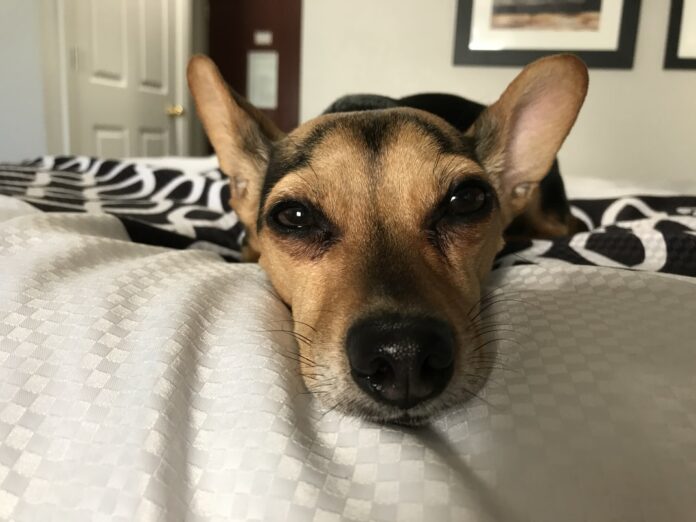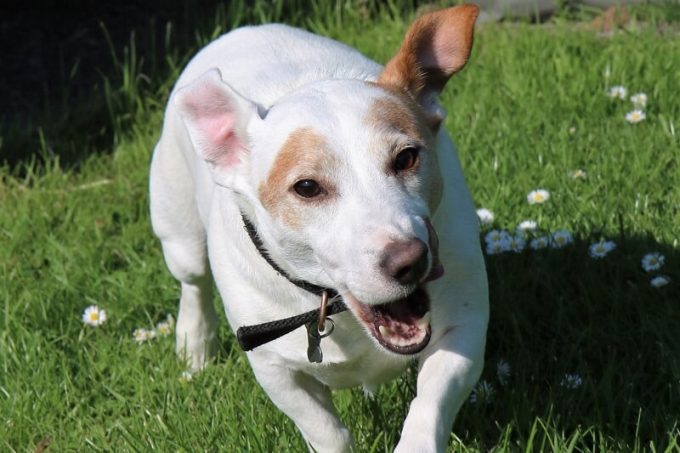The curious and inquisitive nature of a dog is what gives them adventurer-like qualities. But sometimes, their love to explore things may land them in great trouble. There are many cases where dogs somehow end up with foreign objects lodged in their throat or windpipe.
Choking and unable to breathe, this could be a life-threatening situation that requires immediate aiding techniques like CPR and the Heimlich maneuver. Unfortunately, most pet owners don’t know how to give a dog the Heimlich maneuver.
Why do you need to learn it? When faced with such an undesirable situation, you can’t just sit and wait for veterinary assistance. It is your time to act immediately. Knowing how to perform the Heimlich maneuver will allow you to save your dog’s life where it would have been lost otherwise.

If you don’t know how to perform it, no need to worry since we are here to guide you. Once you’re done with this article, you will have mastered different ways to perform it effectively—theoretically, of course (you’ll still need to apply these theories into actual practice to truly master them). Scroll through our step-by-step guide to release your furry friend from a choking nightmare.
How Do You Know Whether Your Dog Needs Help?

Dogs are always up to eating weird things. And it is very common for them to get some stuff caught in their mouth or windpipe. Pieces of sticks, toys, balls, rawhide, cloths, and bones are the most common culprits in such cases. So how would you accurately determine whether he needs your intervention or not?
As long as your dog is coughing, it can be categorized as safe and he should be given a chance to dislodge the object himself (best case scenario). Wait for a bit — if your dog succeeds, that is great.
After that, you should give him a reassuring pat on his head. But if he fails to dislodge the object on his own and the trouble continues, he needs your help. The situations when you must intervene include:
- When your pooch is choking but not coughing
- When your furry friend is facing difficulty in inhaling and exhaling
- When your dog seems panicked
- When your dog is pawing at his face continuously
If your pooch only coughs occasionally—especially with gaps during which you find him doing OK—that means he is not choking. This could be a normal cough or throat infection. You can still check on him for your satisfaction or if you’re worried about some other health issues.
Steps to Relieve Your Dog From Choking
Once you have set your mind to helping your choking friend, the following are the basic steps that you must attempt:
- Step 1: Confirm it!
- Step 2: Back Blow Method
- Step 3: Gravity Method
- Step 4: Different Heimlich Maneuver Methods According to the Dog’s Size
Step One: Confirm It!
Obviously, the pooch can’t say what he is going through. It is necessary to confirm whether the dog is really choking or not yourself. As mentioned above, the most common signs that a dog shows in such cases include—retching, hacking, pawing at his mouth, gasping, and producing a severe cough with bulging eyes.
To check the problem, the first and the most challenging thing to do is to open your pup’s mouth and look for the obstruction. We know that this dog is your most trustworthy companion, but in a situation like this, dogs may act frantically and you can get bitten. Following are some tips to help you get out of this predicament with your dog and yourself intact:
- Don’t do it alone! You must have another fellow assisting you.
- Arrange a flashlight to check dog’s mouth and throat.
- Use both of your hands to open the pooch’s mouth while your fellow holds the flashlight and take a look inside.
- Accurate hands positioning is crucial to avoid a dog’s bite. Hold the top canine teeth with a strong grip with one hand. Then use the other hand to open the mouth. This is the most recommended method for saving yourself from getting bitten.
- Pull down your pet’s tongue to get a clearer view in the throat.
- In case you spot the foreign object inside, try to get it out manually (with your fingers). If you can’t reach it, you can use the flat side of the spoon to bring it closer.
- Removing the foreign object involves the risk of pushing the obstruction deep inside the trachea, which might cause severe damage to the internal tissues in dog’s throat.
- Remove the object only if it feels like it is coming off easily. If it feels stuck, do not use force.
Step Two: Back Blow Method
Before you apply the Heimlich maneuver, try the back blowing method first. Sometimes, simply following this method helps in excreting the object.

Give your furry pet about five solid blows between his shoulder blades. If your dog coughs out the foreign object, then problem solved. If your dog does not, then it’s time to attempt some other measures.
Step Three: Gravity Method
Yet another effective method you may try is the gravity method. Simply raise your canine’s hind legs in the air. The legs should be higher than his head. This is usually an effective method. Gravity force will usually kick in and help the object gets expelled conveniently. However, if this method isn’t enough either, then it’s time to attempt the Heimlich maneuver.
Step Four: Heimlich Maneuver Methods According to the Dog’s Size

Heimlich maneuver techniques vary with the dog’s size as there is one technique for small dogs and another for medium to large-sized breeds.
1. The technique for Medium-sized Dogs
This technique involves the use of force against the ribs. Pressure should be generated around the lower ribs area to dislodge the stuck object from the trachea. Hands are placed below the last rib and you should squeeze in an inward to upward movement.
One thing you need to be aware of: pet owners with less or no prior experience might cause injury to their dog’s ribs by pressing excessively. Unlike human ribs, a dog’s ribs are softer and more flexible. So, you have to be extra careful while performing this technique.
2. The technique for Larger Breeds
For dogs that are bigger in size, the Heimlich maneuver can be tried in different ways. If you don’t get the desired results from one, try the other. Check out the most common positions used for de-choking medium to large sized dogs:
- Kneel down behind your pet (if he is heavy to lift) and wrap your arms around the dog’s waist in a standing position. Use some force to press below the ribcage.
- Secondly, kneel down in the same position and use your fist to thrust forward and upwards on the lower abdominal area. Hopefully, a few quick and forced thrusts would help in dislodging the obstruction. Remove the object with your finger instantly when expelled.
- Get your dog in a laid down position (preferably with a pillow under his hindquarters) on his right side. Put some pressure on his abdomen area with your hands giving upward thrusts. Doing this would force the air into the lungs to move into the esophagus. Once you’re done, you are quite likely to see the object expelled.
- Get your dog laid flat on his stomach. Use your palms to press on the area around the shoulder blades. Keep on repeating the same action for about 5 times.
- You can try an upside-down position as well. The dog’s back should be against your chest. Wrap your arms below the ribcage and clasp your hands strongly. Use your arms to give some quick and sharp pushes to remove the debris.
3. The technique for Small Breeds
If your dog is small, the above methods may be a bit too extreme. Small sized dogs are actually easier to handle in such situations.
Simply follow these steps:
- Get the small dog in your lap and hold its back against your chest with one hand.
- Use the other hand’s fist to perform quick thrusting movements (four to five times) in an upward and inward direction right below its abdomen or at the end of its sternum.
- Once you are done with that, sweep your fingers across his mouth and look for the object in the airway. If the object is dislodged, remove it using your hand.
- In case the obstruction is still not dislodged, lift your small-sized dog with his hind legs. Suspend him in the air and sway him for a few times and then check again for the foreign object.
Things to Remember!

- We have mentioned a number of methods to dislodge the obstruction. If you do not get success with one technique, try the other. Keep on repeating them till the problem is solved.
- In some extreme choking cases, the dog might lay unconscious. How would you give the Heimlich maneuver to an unconscious dog? Lay him down on his right side and opt for CPR (blowing air in the dog’s nose about 5 times, with his mouth closed) till the breathing is restored. To remove the obstruction, CPR and the thrusting of the abdomen go side by side. Keep on recovering his breath (with CPR or artificial respiration) and thrusting his abdomen till the foreign object comes out.
- Remember, CPR is recommended only when your dog does not have a pulse.
- You must know how to check a dog’s pulse. While you would typically check a human’s pulse by pressing your fingers onto the skin of their neck or wrist, for a dog the easiest way to check it is by going for the inner thigh—on the hind leg and almost at the spot where the leg meets the body.
- If you find it hard to detect the pulse in an aforementioned way, check his heartbeat
- In case you have found the pulse but your dog is not breathing, avoid CPR and go for the artificial respiration method instead.
- A dog’s throat consists of small and delicate bones that function to support the dog’s tongue. Make sure you are not mistaking these bones as the obstruction. Accidental pulling on any of these bones may cause severe oral injury.
- It is really important for pet parents to keep calm while facing it all.
- Keep your dog calm as well. If the dog gets agitated and out of control, cool him down by pouring cold water on his belly, feet, and ears.
Is It Necessary to Visit a Veterinarian?
Whether you are successful or not at dislodging the foreign object, you can’t deny the role of a veterinarian. You must visit the expert in both cases. If the Heimlich maneuver technique does not work for your pet, call the vet’s office to arrange immediate medical assistance.
Even if you have dislodged the obstruction successfully, you must still visit your vet for additional guidance. A vet would look for some injury or damage to the dog’s throat and guide you accordingly.
Tips to Prevent Such Situations
Prevention is the best solution for such cases. There are a lot of practices that can save your pet from such a painful experience, like:
- Make sure you are not offering fish or poultry with the bones still mixed into your dog.
- Not every object is suitable for your pup. It is recommended that you give him toys that are designed specifically for dogs.
- Chews, large food chunks (gristle), and dog T-bones are some of the items that must be avoided for dogs.
- Last but surely not least, always keep an eye on your dog. Supervise your pooch to see what he is chewing on.
Wrap Up
Dealing with a choking pet is a heart-breaking and tough situation. But the sooner you act, the better it will be for your dog (and for you obviously).
We hope the aforementioned tips, techniques, and suggestions would be helpful for you in getting your pet out of trouble. One last thing that we would like to suggest is to look for some pet first-aid courses in your city. As a vet may not always be present to help you, a properly trained pet owner can sometimes be the only one who can save their pet from any kind of tragedy.




